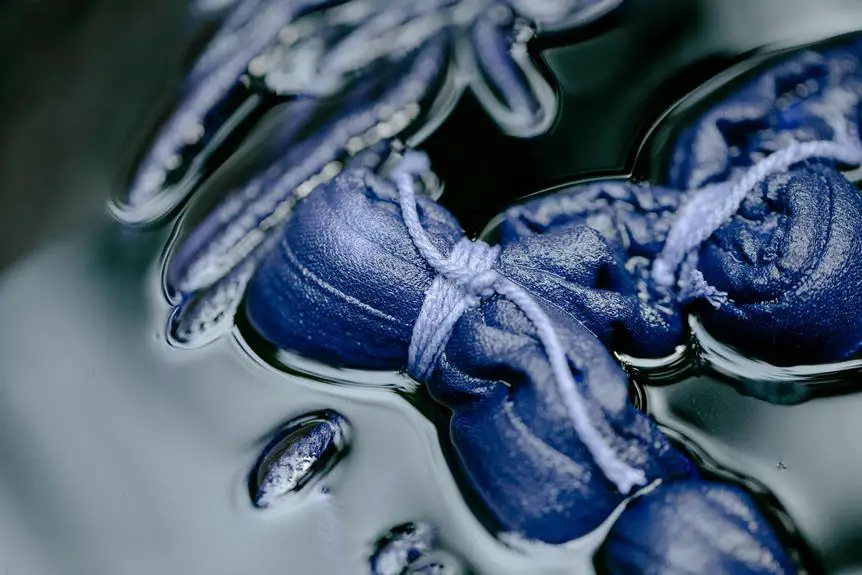When you decide to dye damask fabric, you're not just transforming its color; you're enhancing its intricate patterns and textures. Start by understanding the unique characteristics of damask, as this will influence your dye choice and application method. It's essential to prepare the fabric properly to ensure the dye adheres effectively. From selecting the right dye to mastering the application techniques, there are several key steps involved that can make or break your project. So, what's the best way to achieve vibrant, lasting results? Let's explore the process together.
Table of Contents
Understanding Damask Fabric
Damask fabric, known for its intricate patterns and luxurious feel, is typically woven from silk, linen, or cotton, making it a popular choice for upholstery and elegant clothing. You'll find that the unique weaving technique creates a reversible design, which adds depth and texture to any project. This fabric stands out for its ability to maintain its beauty over time, even with regular use.
When working with damask, you should consider its weight and drape. Heavier damask holds its shape well, making it ideal for structured garments or upholstery, while lighter options flow beautifully, perfect for dresses or curtains. Understanding the characteristics of the fabric helps you make informed decisions during your dyeing process.
You'll also notice that damask can be prone to fading, especially with direct sunlight exposure. This aspect is essential to keep in mind when choosing where to display or use your dyed fabric. Familiarizing yourself with damask's unique properties ensures you approach dyeing with the proper techniques and expectations, allowing you to create stunning results that enhance its luxurious feel.
Choosing the Right Dye
Selecting the right dye for your damask fabric is crucial to achieving vibrant, long-lasting color that complements its intricate patterns.
First, consider the fiber content of your fabric; natural fibers like cotton, silk, or linen typically work well with fiber-reactive or acid dyes. Synthetic fibers, such as polyester, require disperse dyes for effective coloring.
Next, think about the desired color. If you're aiming for a bold hue, opt for concentrated dyes. For softer shades, you might need to dilute your dye solution. Remember, dyeing is often a trial-and-error process, so it's smart to test on a small fabric swatch first.
Also, check whether the dye is suitable for the dyeing method you plan to use, whether it's immersion, tie-dye, or spray dyeing. Some dyes work better with certain techniques.
Lastly, don't forget to consider the dye's wash and lightfastness; you want your fabric to maintain its beauty over time.
Preparing the Fabric
Before you start dyeing, it's important to prepare your damask fabric properly to ensure even color absorption and avoid any unwanted results.
First, wash the fabric to remove any dirt, dust, or finishes that could interfere with the dye. Use a gentle detergent and cold water, then rinse thoroughly. Avoid using fabric softeners, as they can create a barrier that prevents the dye from penetrating the fibers.
Next, if your damask fabric has any stains, treat them before dyeing. You can use a stain remover suitable for the fabric type. Always perform a patch test in an inconspicuous area to make sure the dye won't react negatively with the fabric.
Once the fabric is clean and stain-free, soak it in a solution of warm water and a fixative, like salt or vinegar, depending on the type of dye you'll use. This step helps ensure that the dye adheres well to the fibers.
After soaking for about 30 minutes, rinse the fabric again, and let it dry slightly before you proceed to the dyeing process. Proper preparation will set you up for successful results and vibrant colors.
Dyeing Techniques to Use
When you're ready to add color to your damask fabric, you'll want to consider your dye options.
You can choose between natural dyes, which offer a unique, eco-friendly approach, or synthetic dyes for vibrant, long-lasting results.
Each technique has its own benefits, so let's explore what works best for your project.
Natural Dye Options
Often, you'll find that natural dye options offer vibrant colors and unique textures, making them a fantastic choice for dyeing damask fabric. These dyes come from plants, minerals, and insects, providing a range of hues that are not only beautiful but also eco-friendly.
Here's a quick reference table for some popular natural dye sources and the colors they produce:
| Natural Dye Source | Color Produced |
|---|---|
| Indigo | Deep blue |
| Madder root | Rich red |
| Turmeric | Bright yellow |
| Weld | Vivid yellow |
| Cochineal | Vivid pink/red |
When using natural dyes, preparation is key. You'll want to mordant your fabric to help the color adhere better. Common mordants include alum and tannin. Depending on the dye, the process can involve simmering the dye source in water and then soaking your damask fabric in this mixture. You'll achieve different shades based on the dye source, the mordant used, and the duration of the dye bath. The results can be stunning, lending your damask fabric a one-of-a-kind appearance.
Synthetic Dye Methods
While natural dyes offer unique qualities, synthetic dye methods provide a wider range of colors and more consistent results for dyeing damask fabric.
If you decide to go this route, start by selecting the right synthetic dye, such as fiber-reactive or all-purpose dyes, which work well with different fabric types.
Before dyeing, prepare your damask by washing it to remove any finishes that might interfere with dye absorption. If you want a specific color, mix dyes according to the instructions, ensuring you wear gloves to protect your hands.
Next, dissolve the dye in warm water and add a fixative, such as salt or vinegar, depending on the dye type.
Submerge your fabric in the dye bath, stirring continuously to ensure even coverage. The longer you leave it in, the deeper the color will be.
After reaching your desired shade, rinse the damask in cold water until it runs clear.
Rinsing and Setting the Color
After dyeing your damask fabric, you'll need to rinse it thoroughly to remove excess dye and set the color for lasting vibrancy.
Start by filling a large basin or sink with cool water. Gently submerge your fabric, allowing it to soak for a few minutes. This helps to loosen any remaining dye particles.
Next, carefully agitate the fabric by swishing it around in the water. Avoid wringing or twisting it, as this can distort the delicate fibers. Rinse until the water runs clear, which indicates that most of the excess dye is gone.
Once rinsed, you can set the color by adding a fixative solution, if your dye requires it. Follow the instructions on the dye package, as different dyes may have specific setting agents.
After applying the fixative, let the fabric soak for the recommended time, then rinse again with cool water to remove any leftover fixative.
Care Instructions for Dyed Fabric
Once you've dyed your damask fabric, taking care of it is crucial for maintaining its beauty.
You'll want to use specific washing techniques to ensure durability, as well as storage recommendations to keep it looking great over time.
Let's explore how to best care for your newly dyed fabric.
Washing Techniques for Durability
To maintain the vibrancy and durability of your dyed damask fabric, always wash it in cold water with a gentle detergent. Hot water can cause colors to fade, while harsh detergents can damage the fibers.
Make sure to turn the fabric inside out before washing to protect its surface and reduce friction. If you're using a washing machine, select a delicate cycle to minimize agitation. This helps prevent any potential damage to the fabric's intricate patterns.
You can also consider placing your damask fabric in a mesh laundry bag for added protection. If you prefer hand washing, gently agitate the fabric in a basin filled with cold water and detergent, then rinse thoroughly.
Avoid using bleach or fabric softeners, as they can adversely affect the dye and texture. After rinsing, gently squeeze out excess water without wringing, and lay the fabric flat to dry. If you hang it up, use a padded hanger to maintain its shape.
Following these washing techniques will help keep your dyed damask fabric looking fresh and beautiful for years to come.
Storage Recommendations for Longevity
Properly storing your dyed damask fabric is essential for preserving its colors and preventing damage over time.
First, make sure the fabric is completely dry before storing it. Moisture can lead to mildew and fading, ruining your hard work.
Next, choose a cool, dark place for storage. Light, especially sunlight, can cause colors to fade, so avoid exposing your fabric to direct sunlight. If possible, use acid-free tissue paper to wrap the fabric. This helps prevent creasing and protects it from dust.
Avoid plastic bags or containers, as they can trap moisture and lead to mold. Instead, opt for breathable cotton storage bags or boxes. If you fold the fabric, be sure to place tissue paper between folds to prevent creases and wear.
Lastly, regularly check on your stored fabric. Make sure it remains dry and free from pests. If you notice any issues, take immediate action to preserve your fabric.
Following these guidelines will help ensure your dyed damask fabric remains vibrant and beautiful for years to come.
Frequently Asked Questions
Can I Dye Damask Fabric Multiple Colors at Once?
Yes, you can definitely dye damask fabric multiple colors at once. Just ensure you use different dyeing techniques for each color, and be mindful of how the colors will interact to achieve your desired effect.
What Is the Best Method for Tie-Dyeing Damask?
To tie-dye damask, you'll want to gather your fabric, rubber bands, and fabric dye. Twist or fold the fabric, secure it tightly with bands, then apply dye in your chosen colors for vibrant patterns.
Is It Safe to Dye Damask Fabric at Home?
Dyeing damask fabric at home can be safe if you take proper precautions. Use non-toxic dyes, work in a well-ventilated area, and wear protective gear to ensure your safety during the process.
How Do I Know if My Dye Is Colorfast?
To determine if your dye's colorfast, test a small fabric piece. Wet it, then rub it with a white cloth. If the color transfers, it isn't colorfast. Choose a different dye for best results.
Can I Use Natural Dyes on Damask Fabric?
Yes, you can use natural dyes on damask fabric! Just ensure your fabric is suitable and prepped properly. Experiment with different plants or materials, but remember that results may vary, and colorfastness can be an issue.
- How Does Ring Spun Cotton Affect Garment Fit and Shape Retention? - August 13, 2024
- What Are the Challenges in Producing Ring Spun Cotton? - August 13, 2024
- Is Ring Spun Cotton Suitable for Plus-Size Clothing? - August 13, 2024







